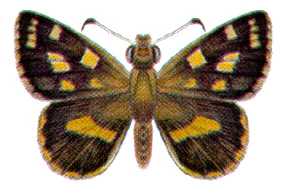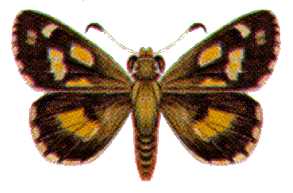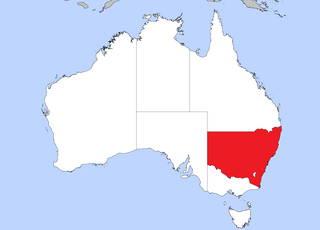
The Apudthama National Park is a national park in Queensland, Australia, 2,137 km (1,328 mi) northwest of Brisbane and about 900 km (559 mi) northwest of Cairns, on the tip of Cape York Peninsula.

Vachellia sieberiana, until recently known as Acacia sieberiana and commonly known as the paperbark thorn or paperbark acacia, is a tree native to southern Africa and introduced into Pakistan. It is used in many areas for various purposes. The tree varies from 3 to 25 m in height, with a trunk diameter of 0.6 to 1.8 m. It is not listed as being a threatened species.
Franz Wilhelm Sieber, was a botanist and collector who travelled to Europe, the Middle East, Southern Africa and Australia.

Anisynta cynone, the mottled grass-skipper or cynone skipper, is a species of butterfly of the family Hesperiidae. It is found in the Australian states of New South Wales, Victoria and South Australia.

Antipodia chaostola, the chaostola skipper, is a species of butterfly of the family Hesperiidae. It is found in Australia along the coast of Victoria, New South Wales and Tasmania.

Tisiphone helena, the Helena brown or northern sword-grass brown, is a nymphalid butterfly. It is endemic to tropical northern Queensland.

Hesperilla chrysotricha, also known as the chrysotricha skipper or goldenhaired sedge-skipper, is a species of butterfly in the family Hesperiidae. It is found in the Australian states of Victoria, Tasmania, South Australia and Western Australia.

Hesperilla crypsargyra, also known as the silvered skipper or silver hedge-skipper, is a species of butterfly in the family Hesperiidae. It is found in the Australian states of New South Wales, Queensland and Victoria.

Hesperilla donnysa, also known as the donnysa skipper or varied sedge skipper, is a species of butterfly in the family Hesperiidae. It is found in the Australian Capital Territory, New South Wales, Queensland, South Australia, Tasmania, Victoria and Western Australia.

Hesperilla idothea, commonly known as the flame sedge-skipper, is a species of butterfly in the family Hesperiidae. It is found in the Australian states of New South Wales, Queensland, South Australia and Victoria.

Hesperilla ornata, also known as the spotted skipper or spotted sedge-skipper, is a species of butterfly in the family Hesperiidae. It is found along the non-tropical eastern seaboard of mainland Australia and in the adjacent mountain ranges.

Hesperilla perornata, the montane sedge-skipper or mountain spotted skipper, is a butterfly of the family Hesperiidae. It is found in the mountains of the Australian states of New South Wales and Victoria.

Timoconia peron, the large dingy skipper or dingy grass-skipper, is a butterfly of the family Hesperiidae. It is found in the Australian Capital Territory, New South Wales, Queensland and Victoria.
Elachista mundula is a moth of the family Elachistidae. It is found in South Australia, Victoria and Tasmania.
The Burrinjuck Nature Reserve is a protected nature reserve on the south west slopes of New South Wales, Australia. The 5,250-hectare (13,000-acre) reserve is located adjacent to the Burrinjuck Dam, with 5,118 hectares of the reserve located on the northern side of the reservoir, and the remaining 89 hectares located on the southern side of the reservoir to the northeast of Black Andrew Nature Reserve. It includes land formerly managed as the Burrinjuck State Forest and Burrinjuck State Recreation Area.
Cassia sieberiana, the drumstick tree, is a tree in the family Fabaceae native to Africa. It ranges from 10 to 20 metres in height and has very bright yellow flowers. It is used for multiple medical purposes in Africa and is found in the secondary jungle of a forest.

Gahnia sieberiana, commonly known as the red-fruit saw-sedge, is a tussock-forming perennial plant in the family Cyperaceae, endemic to Australia. It is a widespread plant that favours damp sunny sites. Many insect larvae have been recorded feeding on the red-fruit saw-sedge. It may grow over 2 metres tall.

Thaxterogaster cinereoroseolus is a species of truffle-like fungus in the family Cortinariaceae. Found in New South Wales, Australia, the species was described as new to science in 2010.

Poa sieberiana, commonly known as grey tussock-grass and snow grass, is a species of tussock grass that is endemic to Australia.

Crassula sieberiana, the Australian stonecrop is a succulent plant found in a variety of habitats in Australia, New Zealand and Lord Howe Island. It has been introduced to Hawaii. Usually seen in rock crevices. It may be found in desert areas such as Sturt National Park, or high rainfall areas near the coast including rainforest. Sub species are not recognized on New South Wales Plantnet, however some authors recognize several subspecies. It is listed as endangered in South Australia.















